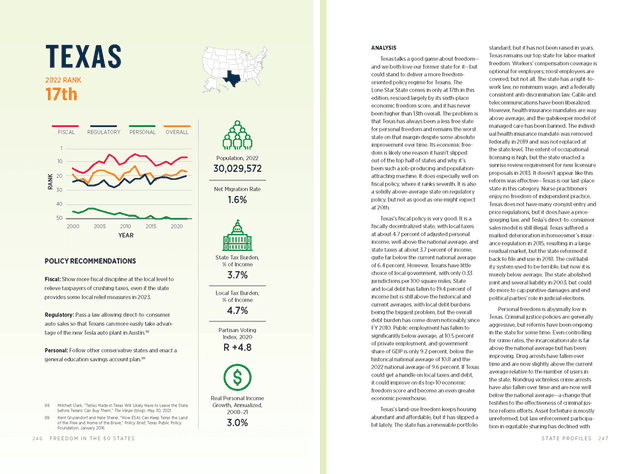Policy Recommendations
- Fiscal Show more fiscal discipline at the local level to relieve taxpayers of crushing taxes, even if the state provides some local relief measures in 2023.
- Regulatory Pass a law allowing direct-to-consumer auto sales so that Texans can more easily take advantage of the new Tesla auto plant in Austin.
- Personal Follow other conservative states and enact a general education savings account plan.
Analysis
Texas talks a good game about freedom—and we both love our former state for it—but could stand to deliver a more freedom-oriented policy regime for Texans. The Lone Star State comes in only at 17th in this edition, rescued largely by its sixth-place economic freedom score, and it has never been higher than 13th overall. The problem is that Texas has always been a less free state for personal freedom and remains the worst state on that margin despite some absolute improvement over time. Its economic freedom is likely one reason it hasn’t slipped out of the top half of states and why it’s been such a job-producing and population-attracting machine. It does especially well on fiscal policy, where it ranks seventh. It is also a solidly above-average state on regulatory policy, but not as good as one might expect at 20th.
Texas’s fiscal policy is very good. It is a fiscally decentralized state, with local taxes at about 4.7 percent of adjusted personal income, well above the national average, and state taxes at about 3.7 percent of income, quite far below the current national average of 6.4 percent. However, Texans have little choice of local government, with only 0.33 jurisdictions per 100 square miles. State and local debt has fallen to 19.4 percent of income but is still above the historical and current averages, with local debt burdens being the biggest problem, but the overall debt burden has come down noticeably since FY 2010. Public employment has fallen to significantly below average, at 10.5 percent of private employment, and government share of GDP is only 9.2 percent, below the historical national average of 10.8 and the 2022 national average of 9.6 percent. If Texas could get a handle on local taxes and debt, it could improve on its top-10 economic freedom score and become an even greater economic powerhouse.
Texas’s land-use freedom keeps housing abundant and affordable, but it has slipped a bit lately. The state has a renewable portfolio standard, but it has not been raised in years. Texas remains our top state for labor-market freedom. Workers’ compensation coverage is optional for employers; most employees are covered, but not all. The state has a right-to-work law, no minimum wage, and a federally consistent anti-discrimination law. Cable and telecommunications have been liberalized. However, health insurance mandates are way above average, and the gatekeeper model of managed care has been banned. The individual health insurance mandate was removed federally in 2019 and was not replaced at the state level. The extent of occupational licensing is high, but the state enacted a sunrise review requirement for new licensure proposals in 2013. It doesn’t appear like this reform was effective—Texas is our last-place state in this category. Nurse practitioners enjoy no freedom of independent practice. Texas does not have many cronyist entry and price regulations, but it does have a price-gouging law, and Tesla’s direct-to-consumer sales model is still illegal. Texas suffered a marked deterioration in homeowner’s insurance regulation in 2015, resulting in a large residual market, but the state reformed it back to file and use in 2018. The civil liability system used to be terrible, but now it is merely below average. The state abolished joint and several liability in 2003, but could do more to cap punitive damages and end political parties’ role in judicial elections.
Personal freedom is abysmally low in Texas. Criminal justice policies are generally aggressive, but reforms have been ongoing in the state for some time. Even controlling for crime rates, the incarceration rate is far above the national average but has been improving. Drug arrests have fallen over time and are now slightly above the current average relative to the number of users in the state. Nondrug victimless crime arrests have also fallen over time and are now well below the national average—a change that testifies to the effectiveness of criminal justice reform efforts. Asset forfeiture is mostly unreformed, but law enforcement participation in equitable sharing has declined with regard to revenues. Cannabis laws are not only harsh; they are the worst in the country. Even cultivating seven grams or more carries a mandatory minimum of six months. In 2013–14, the state banned the mostly harmless psychedelic Salvia divinorum. Access to medical marijuana was expanded in 2021, however. Travel freedom is low. The state requires fingerprints for driver’s licenses and does not regulate automated license plate readers. It has little legal gambling; sports betting remains illegal. Educational freedom is meager in Texas, which has lagged behind other conservative states. It has no private school choice programs (though reform efforts are ongoing in the state as we go to press in 2023), but at least private schools and homeschools are largely unregulated. Tobacco freedom is moderate, as smoking bans have not gone as far as in other states. Gun rights are above average, and the state is now in the top half after languishing for years despite Texas’s reputation. Open carry was legalized in 2015. The big positive reform came in 2021 with the passage of constitutional carry. Alcohol freedom is above average, with taxes low. Texas has virtually no campaign finance regulations.

